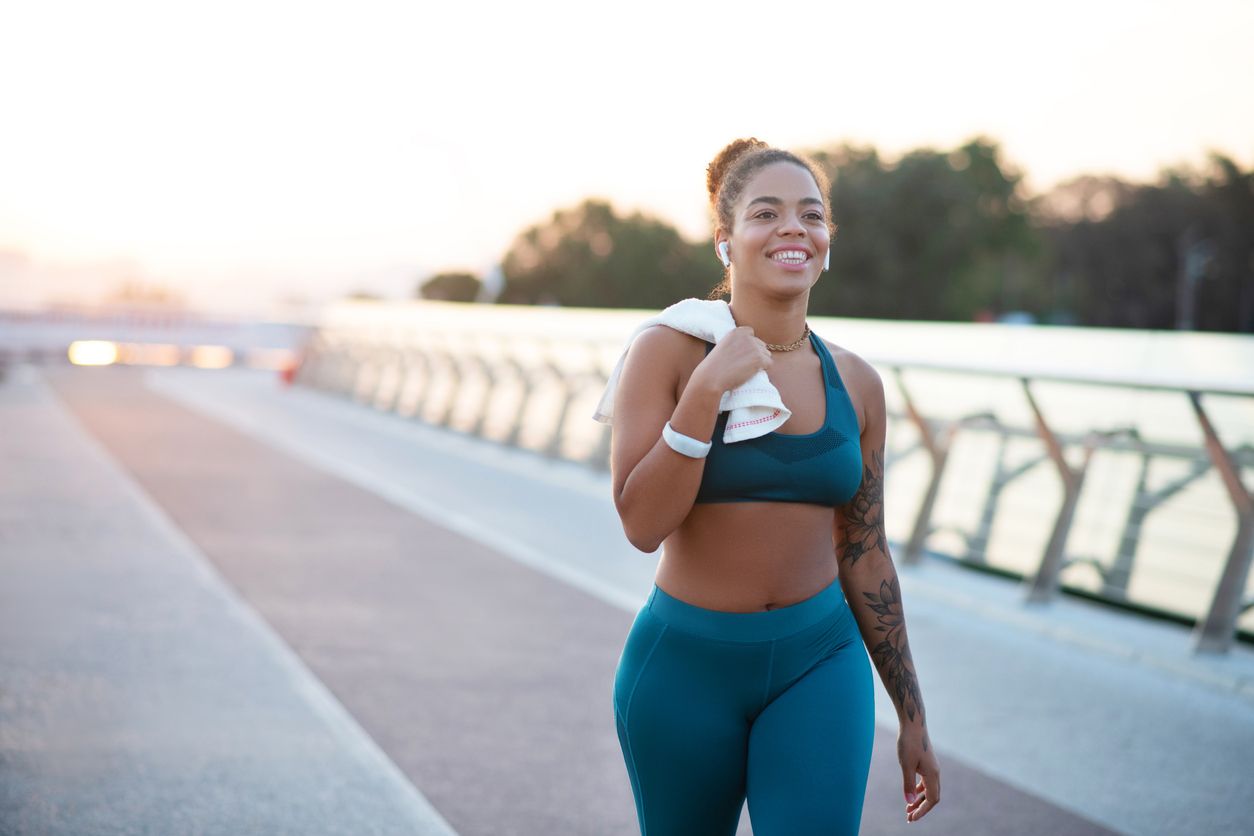
Author: Natalie Ng|Updated: 8 May 2025
Most people walk every day—between errands, commuting, or just getting around. But with a few smart changes, that daily walking routine can do a lot more than get you from point A to B. It can become a reliable part of your weight loss journey, help you burn more calories, and even support better mental health. Small shifts in posture, pace, and terrain can change how your body responds. Brisk walking engages more muscles, helps increase metabolism, and improves cardiovascular health over time. The added bonus is that walking regularly brings long-term benefits for heart health, weight management, and overall fitness—especially when combined with a healthy diet and other forms of regular exercise. Walking for weight loss isn’t about hitting a specific step count or going farther every day. It’s about using your daily routine in a way that makes every step count, whether you're on your lunch break, exploring more challenging routes, or walking with a group to stay motivated. If your goal is to lose weight, build lean muscle, and improve your physical and mental health, keep reading. These tips will help you get more out of every walk without changing your whole life.

1. Master the Power Walking Form

Improve posture for better movement
Stand upright with your shoulders relaxed and your head in line with your spine. Keep your eyes forward, not down. This position helps your body stay aligned and reduces unnecessary strain, especially if you’re walking regularly or covering longer distances.
Engage arms and core
Bend your arms at about 90 degrees and swing them as you walk. Move your arms in line with your natural pace, opposite to your legs. This keeps your rhythm steady, activates more muscles, and supports better balance. At the same time, lightly engage your core muscles. This improves stability and protects your lower back while you walk.
Focus on each step
Walk with intention. Push off from your back foot, land on your heel, and roll through your foot to your toes. This motion helps you activate more muscles and increase calorie burn without putting too much pressure on your knees or hips. Avoid long strides. Instead, take shorter, faster steps. This keeps your walking briskly while lowering the risk of joint pain.
Match your breathing to your pace
Breathe through both your nose and mouth in a steady rhythm. Smooth breathing helps deliver oxygen to your muscles and supports better performance, especially if you're walking for weight loss or working on your cardiovascular health.
Improving your walking form may feel small, but it plays a major role in weight loss, calorie burn, and reducing your body fat over time. Mastering the basics here sets the stage for bigger health benefits in your daily walking routine.

2. Strategic Speed Intervals

Alternate pace to burn more calories
Once your walking form feels solid, it’s time to start shifting your pace. Speed intervals—short bursts of faster walking—are a simple way to make your walks more effective. This technique helps increase your heart rate, improve cardiovascular health, and burn more calories in less time. It also supports weight loss by increasing the overall intensity of your walking routine without needing to add extra hours.
Start each session with a 5-minute warm-up at a normal pace. Once your body is ready, alternate between faster walking and easier recovery periods.
Build your interval timing gradually
Begin with 30 seconds of brisk walking followed by 2 minutes of walking at your regular pace. As your fitness level improves, shift to 45 seconds of speed walking with 90 seconds of recovery. Eventually, move toward 60-second bursts followed by equal recovery time. Keep this pattern going for 20–30 minutes to maximize calorie burn and cardiovascular benefits.
Speed intervals don’t just help you lose weight. They also keep your walks more engaging, improve endurance, and push past plateaus that can come with walking regularly at the same pace.
Date should not be before minimal date

2. Strategic Speed Intervals
Alternate pace to burn more calories
Once your walking form feels solid, it’s time to start shifting your pace. Speed intervals—short bursts of faster walking—are a simple way to make your walks more effective. This technique helps increase your heart rate, improve cardiovascular health, and burn more calories in less time. It also supports weight loss by increasing the overall intensity of your walking routine without needing to add extra hours.
Start each session with a 5-minute warm-up at a normal pace. Once your body is ready, alternate between faster walking and easier recovery periods.
Build your interval timing gradually
Begin with 30 seconds of brisk walking followed by 2 minutes of walking at your regular pace. As your fitness level improves, shift to 45 seconds of speed walking with 90 seconds of recovery. Eventually, move toward 60-second bursts followed by equal recovery time. Keep this pattern going for 20–30 minutes to maximize calorie burn and cardiovascular benefits.
Speed intervals don’t just help you lose weight. They also keep your walks more engaging, improve endurance, and push past plateaus that can come with walking regularly at the same pace.

3. Hills and Terrains for Maximum Impact
Walk uphill to build lean muscle
Adding hills to your walking route is one of the most effective ways to increase calorie burn and develop lean muscle. Walking uphill engages more of your lower body—especially your glutes, hamstrings, and calves—while also raising your heart rate. This added effort helps you burn more calories and improve cardiovascular health without needing to walk for longer periods.
Try including both gentle slopes and steeper climbs into your walks. Shift your weight slightly forward from the ankles, keep your spine straight, and engage your core as you move uphill. This posture supports your joints and keeps your movements efficient.
Control your pace downhill
Walking downhill might seem easier, but it still challenges your body in different ways. To reduce stress on your knees, take shorter steps and avoid leaning back. A slight forward lean and strong core engagement will help keep you stable and reduce the risk of joint strain.
Choose uneven surfaces for extra benefits
If hills aren’t available, walking on varied terrain—like grass, packed dirt, or gravel—can create a similar effect. These surfaces force your stabilizing muscles to work harder, especially around your ankles and hips. Over time, this helps improve balance, coordination, and lower body strength.
Using different terrains not only boosts physical activity levels but also helps reduce boredom, making daily walking feel less repetitive and more rewarding.

4. The 80/20 Walking Intensity Rule
Balance intensity to support long-term weight loss
Following the 80/20 rule in your walking routine creates a structured yet flexible way to improve cardiovascular health, increase metabolism, and support weight management. This method means spending 80% of your total walking time at a moderate pace and the remaining 20% walking briskly at higher intensity.
This balance helps you stay active most days without pushing your body too hard. It also improves your ability to burn body fat while building endurance in a sustainable way.
Define your walking pace ranges
During the moderate portion of your walk—about 2.5 to 3.5 mph—you should be able to talk without difficulty. This level supports steady calorie burn and is easy to maintain over longer periods. For the more intense 20%, increase your speed to 4 to 4.5 mph. This faster pace should make talking more difficult and will raise your heart rate into a zone that encourages fat burning and aerobic activity.
Break up intensity into shorter bursts
You don’t need to walk fast all at once. You can break up your high-intensity time into short segments—such as three 5-minute bursts during a 45-minute walk. This makes the workout more manageable while still boosting calorie burn and helping with weight loss.
The 80/20 approach supports both physical and mental health by keeping walks enjoyable while offering real body transformation results.
Date should not be before minimal date

5. Time Your Walks for Metabolic Benefits
Walk after meals to support weight control
The timing of your walks can influence your body’s ability to manage weight and burn calories effectively. Walking shortly after meals—especially after breakfast or dinner—can help regulate blood sugar levels and improve insulin sensitivity. This supports better weight loss outcomes and lowers the risk of conditions like diabetes and cardiovascular disease.
A 15-minute walk after eating is enough to help reduce glucose spikes, especially for those watching their blood sugar. Over time, walking after meals can make weight management more sustainable and support your overall health.
Morning walks to boost metabolism
A walk within 30 minutes of waking up may help increase metabolism. During this time, cortisol levels are naturally higher, which means your body is already in a more active state. Walking briskly in the morning can enhance calorie burn and increase energy for the rest of the day. If your goal is to burn body fat, walking before breakfast—when glycogen stores are lower—may help shift your body toward using fat for fuel.
Evening walks to support sleep and recovery
Taking a walk in the evening supports mental health and recovery. It helps lower stress hormones and signals your body to wind down, improving sleep quality. These benefits also support long-term weight loss and disease control by improving how your body recovers and adapts overnight.

6. Progressive Distance Building
Increase distance to build endurance safely
Gradually increasing your walking distance helps your body adapt without risking injury. This steady progression improves your cardiovascular fitness, builds muscular endurance, and supports more consistent weight loss by increasing the total calories burned over time.
Start by identifying your current baseline—this could be the average distance you cover most days. From there, aim to build on that slowly.
Use weekly milestones to track progress
Add about 10% to your total weekly walking distance every 1 to 2 weeks. For example, if you’re walking 10 km this week, increase it to 11 km next week. Keep your pace steady while adjusting to the new distance. This helps prevent joint strain while still challenging your body.
Include one longer walk each week, about 25–50% farther than your usual walk. This helps boost endurance without overloading your routine. Use a fitness tracker, app, or walking journal to log your distances and how you feel after each session. Tracking both distance and energy levels helps you avoid increasing too quickly.
This method gives your muscles, joints, and heart time to adapt, helping you lose more weight and improve fitness without hitting a plateau.

7. Mind-Muscle Connection While Walking
Engage your core with each step
Focusing on your body as you walk helps make each step more effective. One of the most important parts of this is engaging your core muscles. A strong core improves posture, protects your lower back, and supports better control of movement. This also improves how efficiently you walk, leading to better calorie burn and muscle activation.
Draw your navel gently toward your spine and keep your core lightly engaged as you move. Breathe naturally and avoid tensing up. This connection between your movement and muscle control adds more purpose to your walking routine.
Focus on muscle activation during steps
As your feet move, pay attention to how they make contact with the ground. Land with your heel, roll through your arch, and push off with your toes. This smooth motion helps activate muscles in your feet, legs, and hips. It also strengthens balance and coordination, which is especially important for older adults or anyone working on improving fitness level.
Being aware of how your glutes, calves, and hamstrings feel during movement helps build stronger neuromuscular pathways. Over time, this improves your walking form and prevents fatigue or pain from poor movement patterns.
Use posture checks to stay aligned
Keep your head level, your gaze forward, and your shoulders relaxed. Imagine a string pulling upward from the top of your head to help lengthen your spine. Let your arms swing naturally and avoid hunching forward or arching your back.
Posture awareness improves oxygen flow, walking speed, and overall endurance. It also makes your walking for weight loss efforts more effective, as better form leads to better results.
Date should not be before minimal date

8. Resistance Elements for Enhanced Results
Use hills instead of ankle weights
Adding resistance to your walking routine helps increase calorie burn and develop lean muscle, but it needs to be done safely. While ankle weights might seem like an easy way to add resistance, they can place extra stress on your joints. Most fitness experts recommend avoiding them for regular walks due to the risk of injury.
Instead, walking on hilly terrain naturally increases resistance without compromising your walking form. Uphill walking targets your glutes, calves, and hamstrings, helping you build more muscle and improve cardiovascular health. As a result, you burn more calories and gain strength without needing extra equipment.
Add ankle weights only with caution
If you still choose to use ankle weights, start light—no more than 1–2 pounds. Limit use to short sessions, around 15–20 minutes, and focus on maintaining proper posture throughout. Stop using them immediately if you notice joint discomfort or changes in how you walk.
Ankle weights can be useful in short, controlled sessions for people with higher fitness levels, but for most walkers, hills and varied terrain provide safer, more effective resistance.
Increase hill difficulty gradually
To challenge your body safely, start with gentle slopes. As your strength improves, add steeper inclines. This gradual increase supports better fitness without risking injury. Keep your core engaged and lean forward slightly from your ankles—not your waist—as you walk uphill.
Using resistance in smart ways turns a regular walking routine into a more complete workout that helps burn more calories, build muscle, and support long-term weight management.

9. Recovery and Sustainable Progress Principles
Give your body time to rest and rebuild
As your walking routine becomes more intense—especially with hills, speed intervals, and longer distances—your muscles and joints need time to recover. Recovery allows your body to adapt to the increased physical activity, build strength, and prevent overuse injuries. Without proper rest, you may slow your progress or increase your risk of injury.
Plan rest days between intense walking sessions. For example, if you’ve done a high-effort walk one day, follow it with a lower-intensity session or take the next day off. Most people benefit from at least one to two full rest days per week.
Use active recovery to stay on track
Active recovery means choosing lower-effort walks on certain days instead of complete rest. These walks keep your body moving while reducing overall strain. Walking at a moderate pace for a shorter duration still supports calorie burn and helps your muscles stay flexible and mobile.
Pay attention to how your body feels. If you notice persistent soreness, fatigue, or slower pace than usual, take it as a signal to rest or reduce intensity.
Support recovery with lifestyle choices
Getting enough sleep, staying hydrated, and eating a healthy diet all contribute to better recovery. These habits help your muscles repair and support your overall energy levels. If you're aiming to lose weight or improve fitness, recovery plays just as important a role as the exercise itself.
Long-term progress depends on a walking routine your body can maintain and improve without burnout.

10. Heart Rate Zone Optimization
Stay within your target heart rate range
Monitoring your heart rate during walks helps ensure you're working at the right intensity to support weight loss, improve cardiovascular health, and burn more body fat. Walking briskly while staying in your ideal heart rate zone allows your body to use energy more efficiently, especially during moderate aerobic activity.
To find your estimated maximum heart rate, subtract your age from 220. Aim to keep your heart rate between 60% and 70% of that number for fat-burning benefits. This range supports both body weight control and cardiovascular disease prevention.
Use a fitness tracker for real-time feedback
Using a fitness tracker or heart rate monitor gives you quick, accurate data during your walks. It allows you to adjust your pace as needed to stay in the right zone. If your heart rate drops too low, increase your speed. If it climbs too high, ease into a moderate pace.
This approach turns walking into a more targeted workout that balances calorie burn and heart health. You can also check your heart rate manually by taking your pulse for 15 seconds and multiplying the number by 4 to get beats per minute.
Adjust pace throughout your walk
Start each session with a normal pace for 5 minutes, then increase speed until you’re walking briskly—enough to raise your heart rate but still carry on a short conversation. After about 10 minutes, ease into a slower pace to recover for a few minutes before repeating the cycle.
This variation keeps your cardiovascular system challenged and supports steady improvement in fitness level, weight management, and energy use throughout daily life.
Date should not be before minimal date

Boost Results with S6 Body Sculpting Treatment
Support walking efforts with targeted fat reduction
Daily walking plays a strong role in burning calories, reducing body fat, and improving overall health. But for many people, certain areas of the body—like the belly, thighs, or lower back—tend to hold onto stubborn fat even with regular physical activity and a healthy diet. This is where the S6 Body Sculpting Treatment can help you get closer to your goals.
The S6 Body Sculpting Treatment is a non-invasive body contouring option that works alongside your walking for weight loss efforts. It targets specific problem areas that don’t always respond to walking alone. For people who walk regularly but still struggle to reduce fat in key zones, this treatment can improve visible results and support body shaping in a safe and efficient way.
How the treatment works
S6 uses a low-energy bio-laser that penetrates subcutaneous fat tissue. It breaks down fat cells and releases stored fatty acids for removal through your body’s natural lymphatic system. At the same time, vacuum suction is applied to the treated area, stimulating lymphatic drainage and increasing circulation.
This two-part process boosts your metabolism and helps the body expel fat more efficiently—making it a great pairing with regular walking and moderate aerobic activity. As an added benefit, the treatment also encourages collagen production, which can help tighten and firm the skin around areas that are losing fat.
Benefits of combining S6 with regular walking
• Targets stubborn fat areas like the belly, thighs, and back
• Enhances the effects of daily walking by speeding up fat removal
• Helps develop lean muscle appearance through visible shaping
• Non-surgical, non-invasive, with little to no downtime
• Supports weight loss and body contouring goals with no need for extreme dieting
For anyone already committed to walking regularly and maintaining a healthy lifestyle, S6 Body Sculpting Treatment offers extra support where you need it most.
Ready to take your results further? Book your S6 Body Sculpting session today and turn your walking routine into full-body results.
S6 Body Sculpting TreatmentDate should not be before minimal date
FAQ
1. Does walking for weight loss work without changing my diet?
Walking regularly can help you burn more calories and improve cardiovascular health, but combining it with a healthy diet is what makes weight loss more effective. To lose weight, your body needs to be in a calorie deficit—burning more calories than you consume. Without adjusting your eating habits, the calories burned through walking might not be enough to see major changes in body weight. Pairing daily walking with better food choices helps improve results.
2. Is brisk walking better than walking at a normal pace for weight loss?
Yes, walking briskly helps burn more calories in less time. A brisk pace raises your heart rate, which boosts cardiovascular health and supports fat burning. Compared to walking at a normal pace, brisk walking engages more muscles and increases energy use, which helps with body fat reduction and weight management. Aim for a pace where you can talk, but not sing.
3. How many steps per day should I aim for to lose weight?
While 10,000 steps is a common goal, weight loss depends on your fitness level, diet, and total calorie burn. For some people, 8,000 steps may be enough, while others may need to aim for more. If your main goal is to lose weight, focus on increasing your daily step count gradually and including periods of moderate aerobic activity to burn more calories throughout the day.
4. Can walking reduce belly fat specifically?
Walking helps reduce overall body fat, including fat stored around the belly, but spot reduction is not guaranteed. You can't control exactly where your body loses fat, but consistent walking, combined with a healthy diet and good sleep, will eventually lead to visible fat loss—including belly fat. To support belly fat reduction, walking for weight loss should be paired with stress control and good posture during walks.
5. Is walking enough for older adults trying to lose weight?
Yes, walking is one of the best forms of regular exercise for older adults. It's low-impact, safe for joints, and supports both cardiovascular health and mental health. For older adults looking to lose weight, walking most days of the week, using a fitness tracker to monitor progress, and staying in a moderate heart rate zone can help maintain a healthy body weight. Including gentle resistance training and stretching can also increase benefits.
Recommended Articles
COPYRIGHT© NEW BEAUTY MANAGEMENT LIMITED 2025. ALL RIGHT RESERVED.




